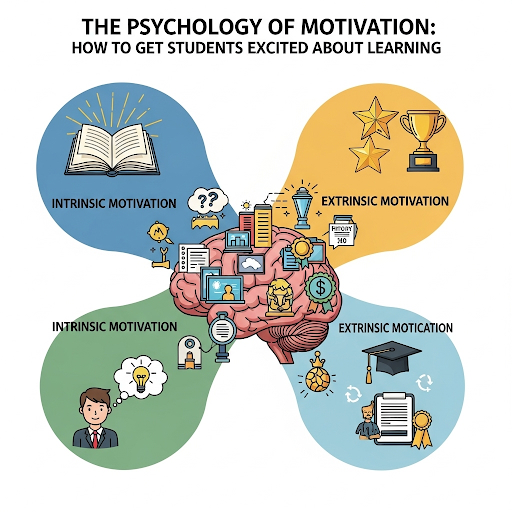
DISCOUNTED EDUCATION PRICING! CALL 1-877-891-8411. We Gladly Accept School Purchase Orders!

Motivation is the invisible engine that drives student success. Teachers often ask: Why do some students eagerly engage with lessons while others seem uninterested or distracted? The answer lies in understanding the psychology of motivation in education and using proven strategies that align with how the brain learns.
In this comprehensive guide, we’ll explore:
Whether you’re a classroom teacher, school administrator, or education coach, these insights can help you create a motivated, engaged, and high-performing classroom environment.
Motivation in education encompasses the complex interplay of internal and external factors that ignite and sustain students’ drive to engage in learning, persevere through academic challenges, and ultimately achieve success in their educational pursuits. Far from being a mere theoretical concept, understanding motivation is a critical component of effective teaching and learning, as it directly influences classroom dynamics, student performance, and long-term academic outcomes.
Internally, motivation can stem from a student’s personal interests, intrinsic curiosity, or a sense of purpose tied to their goals, such as mastering a subject or pursuing a dream career. For example, a student passionate about environmental science might be driven to excel in biology due to a deep desire to address climate change. Externally, motivation can be shaped by factors like supportive teachers, parental encouragement, peer influence, or tangible rewards such as grades or recognition. A teacher’s ability to create a stimulating learning environment—through engaging lessons, positive feedback, or fostering a growth mindset—can significantly amplify a student’s motivation.
Student motivation is not optional—it’s essential for learning outcomes, academic growth, and long-term success.
There are two primary types of motivation that every teacher should understand:
Intrinsic motivation comes from within. Students engage with learning because they find it interesting, enjoyable, or personally meaningful.
Examples of intrinsic motivation in the classroom:
Extrinsic motivation comes from external factors, such as grades, praise, or rewards. While extrinsic motivators can get students to complete tasks, they often don’t inspire long-term engagement.
Examples of extrinsic motivation in the classroom:
Understanding intrinsic vs extrinsic motivation helps teachers create strategies that increase student engagement, classroom participation, and learning outcomes.
Teachers often ask: Should I focus on intrinsic motivation, extrinsic motivation, or both?
The answer: both are necessary, but intrinsic motivation drives lifelong learning.
Best Practice: Pair extrinsic rewards with strategies that foster autonomy and mastery. For instance:
Teachers who balance intrinsic and extrinsic motivation strategies can boost classroom engagement, encourage student participation, and create a love for learning.
Research shows that students who are intrinsically motivated perform better academically and develop a lifelong love of learning. Here are motivation strategies backed by psychology and neuroscience:
Students often ask: “Why do I need to learn this?” Relevance is key.
Examples:
When lessons are connected to real-life situations, students are more likely to engage, retain information, and develop critical thinking skills.
Autonomy is a major factor in intrinsic motivation. Students who feel they have control over their learning are more invested and more likely to persist.
Practical tips:
Focusing solely on grades emphasizes extrinsic motivation. Instead, highlight progress and effort:
This reinforces a growth mindset, where students understand that effort and practice lead to improvement.
Neuroscience confirms that the brain is highly adaptable. Students with a growth mindset are more likely to tackle challenges, take risks, and develop resilience.
Classroom strategies:
FAQ: Does teaching a growth mindset improve motivation?
Answer: Yes. Research shows students with a growth mindset demonstrate higher engagement, persistence, and overall academic performance.
Gamification is the application of game elements in learning. When used thoughtfully, it boosts motivation, engagement, and collaboration. It is a great motivation for students.
FAQ: Can gamification distract students from real learning?
Answer: Not if aligned with curriculum goals. Gamification enhances learning when it encourages collaboration, persistence, and mastery.
Classroom gamification strategies improve student motivation, participation, and engagement by making learning interactive and rewarding.
Brain science reveals why some strategies work better than others:
Classroom Tip: Break larger tasks into smaller, achievable goals to trigger dopamine and reinforce motivation.
Neuroscience shows that curiosity, incremental rewards, and moderate challenges enhance student engagement and learning outcomes.
Long-tail keywords: classroom engagement strategies, student motivation techniques, intrinsic motivation in education, gamification in classrooms, neuroscience of learning
Q1: Can extrinsic rewards harm intrinsic motivation?
Yes, excessive rewards can make students focus only on outcomes. Use rewards as a bridge to encourage curiosity and mastery.
Q2: How do I motivate students who seem disengaged?
Start small: connect lessons to their interests, give choices, celebrate small successes, and build relationships.
Q3: Are some students naturally more motivated than others?
Individual differences exist, but motivation can be nurtured in nearly all students using evidence-based strategies.
Q4: How do I measure student motivation?
Look at engagement indicators like participation, assignment completion, persistence, and willingness to take on challenges.
Understanding the psychology of motivation is essential for teachers who want to create an engaged, dynamic, and high-performing classroom. By combining intrinsic and extrinsic strategies, leveraging gamification, and applying neuroscience insights, educators can help students:
Boost student motivation and classroom engagement with strategies that combine intrinsic motivation, gamification, neuroscience, and practical teaching techniques.